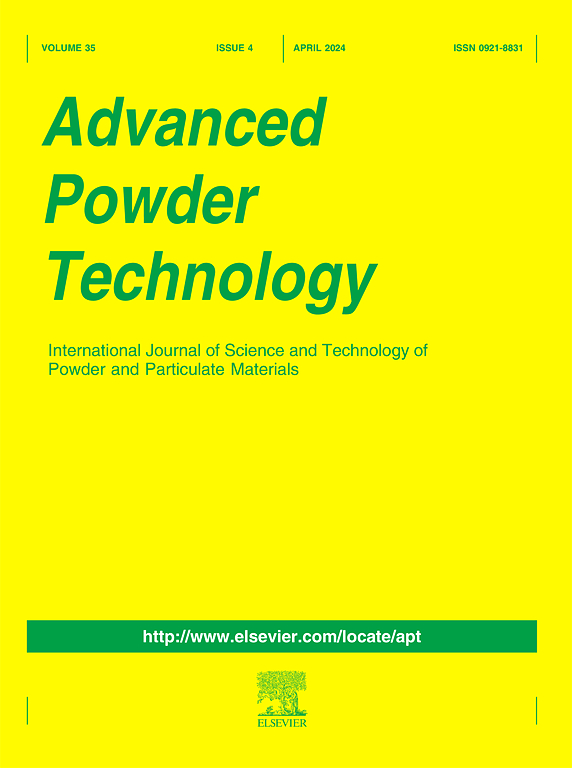制备球形核壳结构炸药的双液滴微流控策略:控制壳厚提高安全性能
IF 4.2
2区 工程技术
Q2 ENGINEERING, CHEMICAL
引用次数: 0
摘要
八氢-1,3,5,7-四氮-1,3,5,7-四氮辛(HMX)是一种高性能炸药,常用于导弹弹头、核武器装药、固体火箭推进剂等军事领域。然而,HMX的高灵敏度限制了它的进一步应用。核壳结构炸药的通用性和可控性可以有效地实现含能材料的改性研究。本文首次通过双液滴微流控策略(DDMS)研究了HMX@DAAF核-壳微球的形成机理,并根据该策略成功制备了不同壳厚的核-壳微球。我们探讨了DAAF壳层厚度对核壳微球形貌、结构和性能的影响,并提出了核壳微球安全性能增强的潜在机制。结果表明:DDMS制备的HMX@DAAF核壳微球球度高,粒径分布窄,流动性好;DAAF外壳起到“盾牌”的作用,保护内部敏感的HMX,其冲击灵敏度和摩擦灵敏度分别提高到100 J和360 N。该研究在核壳炸药的可调性和结构构造方面具有一定的优势,为高质量核壳结构材料的制备提供了一种简单、安全的策略。本文章由计算机程序翻译,如有差异,请以英文原文为准。

Double-droplet microfluidic strategy for preparing spherical core–shell structured explosives: controlling shell thickness to enhance safety performance
Octahydro-1,3,5,7-tetranitro-1,3,5,7-tetrazocine (HMX), as a high-performance explosive, is commonly used in military fields such as missile warheads, nuclear weapon charges, and solid rocket propellants. However, the high sensitivity of HMX limits its further applications. The versatility and controllability of core–shell structured explosives (CESs) can effectively achieve the modification research of energetic materials. Here, for the first time, we investigated the formation mechanism of HMX@DAAF core–shell microspheres through the double-droplet microfluidic strategy (DDMS) and successfully prepared core–shell microspheres with varying shell thicknesses according to this strategy. We explored the impact of the DAAF shell thickness on the morphology, structure, and performance of the core–shell microspheres and proposed a potential mechanism for the enhancement of safety performance of the core–shell microspheres. The results show that DDMS can produce HMX@DAAF core–shell microspheres with high sphericity, narrow particle size distribution, and good fluidity. The DAAF shell acts as a “shield” to protect the sensitive HMX inside, with its impact sensitivity and friction sensitivity increased to 100 J and 360 N, respectively. The study has demonstrated certain advantages in the tunability and structural construction of core–shell explosives, providing a simple and safe strategy for the preparation of high-quality core–shell structured materials.
求助全文
通过发布文献求助,成功后即可免费获取论文全文。
去求助
来源期刊

Advanced Powder Technology
工程技术-工程:化工
CiteScore
9.50
自引率
7.70%
发文量
424
审稿时长
55 days
期刊介绍:
The aim of Advanced Powder Technology is to meet the demand for an international journal that integrates all aspects of science and technology research on powder and particulate materials. The journal fulfills this purpose by publishing original research papers, rapid communications, reviews, and translated articles by prominent researchers worldwide.
The editorial work of Advanced Powder Technology, which was founded as the International Journal of the Society of Powder Technology, Japan, is now shared by distinguished board members, who operate in a unique framework designed to respond to the increasing global demand for articles on not only powder and particles, but also on various materials produced from them.
Advanced Powder Technology covers various areas, but a discussion of powder and particles is required in articles. Topics include: Production of powder and particulate materials in gases and liquids(nanoparticles, fine ceramics, pharmaceuticals, novel functional materials, etc.); Aerosol and colloidal processing; Powder and particle characterization; Dynamics and phenomena; Calculation and simulation (CFD, DEM, Monte Carlo method, population balance, etc.); Measurement and control of powder processes; Particle modification; Comminution; Powder handling and operations (storage, transport, granulation, separation, fluidization, etc.)
 求助内容:
求助内容: 应助结果提醒方式:
应助结果提醒方式:


